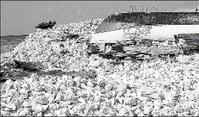
Garbage piled high on Pedro Cays. The problem of waste disposal is a looming health hazard for the people who live and work on the cays. - Photo by Gareth Manning
It is like a little country all by itself. More than 50 miles off the coast of St Elizabeth, there are no police, no members of parliament, only fishermen who make their own rules.
This is the Pedro Cays, desolate, yet alive - a place where hoards of money are made and lost easily in a frenzy of drinking, gambling and prostitution.
Sure, there are Jamaica Defense Force coastguards based here, but without the power to arrest, they cannot interfere in the happenings of this care-free community of fishermen and prostitutes. They provide mediation when they can and basic medical services and other forms of basic services, but there is very little else they can do to prevent the almost daily conflicts that often lead to bloodshed on this little dot of land.
Anything goes here. Domestic disputes are solved with knives and other blunt instruments. As a result, there are often cases of injuries each month, a coastguard medic tells our news team. Just last week, he treated one man for a stab wound he sustained in an incident that involved the theft of a fish pot. Most disagreements are due to petty robberies, they say, but the situation is complicated by the obvious factions on the beach. Middle Cay is split in half. On one side are residents from Rocky Point, Clarendon; on the other side is everyone else.
"The sea can make you miserable more time," a dreadlock fisherman declares. "A just last week, a man get terrible cut up and even this morning, a man get 'juk' (cut) up. A lot of that go on regular," he says in hushed tones.
"We give thanks to JDF still," another fisherman says, "because in case of danger and dem ting there, dem here for we," he continues.
Without running water, there are no adequate sanitary facilities, so urine is passed behind the zinc structures or into the sea. There is a designated place to defecate - three broken structures near the rubbish dump that only females use. Men go behind the thin bushes at the back, near to the sea.
The open face of rubbish, including human excreta, stands tall in the centre of Middle Cay, waiting on heavy rainfall to sweep it along with the tide into the coral-rich ocean.
Other problems
But Middle Cay has other problems. Mountains of conch shells bordering the beach point to overfishing. Added to this is the danger many divers face harvesting the commodity. Conch divers venture into deep water using a compressor unit. Many are not trained to handle the equipment and sometimes, there are fatalities.
"Nuff man come back from sea with the 'bends'," a fisherman informs us. At least three have died in the last two years, says a medic, and numerous others are injured on a regular basis. The sickness causes air bubbles to be formed in the joints and without recompression, death is a likely result. There is only one working recompression unit in Jamaica and it is in Discovery Bay, St Ann. Survival of the victims depends on airlift by the JDF to Discovery Bay, but there are some who take matters into their own hands.
"Some fishermen try to put the man back down in water, but that can only work in mild cases," says one of the medics. The aim is to try in-water recompression, but as expected, in many cases, the severity of the sickness is not usually known and reimmersing the victim only makes things worse.
Government help
Two years ago, Government promised to help the people of the cays. A multisectoral team including the National Solid Waste Management Authority (NSWMA), the National Environment and Planning Agency and the Fisheries Division within the Ministry of Agriculture, was set up to make recommendations for upgrading the cay. To date, nothing has been done, and the problems weigh heavily on the residents.
New executive director the NSWMA, Joan Gordon-Webley, tells The Sunday Gleaner she has no idea of the the extent of the pollution, or that her agency was to be a key player in the maintenance of the cays. She, however, said that she would be visiting the area soon with a view to assessing the conditions.
GM

